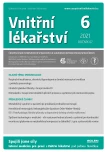High-rank technology in the medicine – the impact of continuous glucose monitoring system alarm settings values on glycemic control in type 1 diabetes patients: a systematic review
Authors:
Jana Urbanová 1; Juraj Michalec 2; Jan Brož 2
Authors‘ workplace:
Interní klinika FNKV a 3. LF UK, Praha
1; Interní klinika FN Motol a 2. LF UK, Praha
2
Published in:
Vnitř Lék 2021; 67(6): 346-350
Category:
Review Articles
Overview
Alarms in continuous glucose monitoring systems (CGM) represent a very important feature enabling to patients with diabetes who use these systems to keep their blood glucose level in the target range and to avoid excursion to hypoglycemia or hyperglycemia. The possibility to warn the patient that the target range has been crossed means one of the main advantages of CGM over the selfmonitoring of blood glucose with personal glucometers, but also (so far) flash glucose monitoring systems. However, there is surprisingly few studies concerning specifically the relationship between the alarms settings and glucose control. Therefore, there are currently no recommendations nor guidelines for optimal settings of alarms in CGM. Limited number of studies suggest that the setting of the hypoglycemia alarm to a level higher than 4 mmol/L is associated with lower frequency and shorter duration of hypoglycemia, and may be temporarily increased to 6 mmol/L in patients with impaired hypoglycemia awareness.
Keywords:
diabetes – hyperglycemia – hypoglycemia – CGM – alarms
Sources
1. Battelino T, Danne T, Bergenstal RM et al. Clinical Targets for Continuous Glucose Monitoring Data Interpretation: Recommendations From the International Consensus on Time in Range. Diabetes Care. 2019; 42(8): 1593–1603.
2. Lin R, Brown F, James S, Jones J, Ekinci E. Continuous glucose monitoring: A review of the evidence in type 1 and 2 diabetes mellitus. Diabetic Medicine. 2021; 18.
3. Lin YK, Groat D, Chan O, Hung M, Sharma A, Varner MW, Gouripeddi R, Facelli JC, Fisher SJ. Alarm Settings of Continuous Glucose Monitoring Systems and Associations to Glucose Outcomes in Type 1 Diabetes. J Endocr Soc. 2019; 4(1): bvz005.
4. Ly TT, Hewitt J, Davey RJ, Lim EM, Davis EA, Jones TW. Improving epinephrine responses in hypoglycemia unawareness with real-time continuous glucose monitoring in adolescents with type 1 diabetes. Diabetes Care. 2011; 34(1): 50–52.
5. Puhr S, Derdzinski M, Welsh JB et al. Real-World Hypoglycemia Avoidance with a Continuous Glucose Monitoring System's Predictive Low Glucose Alert. Diabetes Technol Ther. 2019; 21(4): 155–158.
6. Puhr S, Derdzinski M, Parker AS et al. Real-World Hypoglycemia Avoidance With a Predictive Low Glucose Alert Does Not Depend on Frequent Screen Views. J Diabetes Sci Technol. 2020; 14(1): 83–86.
7. Shivers JP, Mackowiak L, Anhalt H, Zisser H. "Turn it off!": diabetes device alarm fatigue considerations for the present and the future. J Diabetes Sci Technol. 2013; 7(3): 789–94.
8. Palerm CC, Bequette BW. Hypoglycemia detection and prediction using continuous glucose monitoring-a study on hypoglycemic clamp data. J Diabetes Sci Technol. 2007; 1(5): 624–9.
9. Little SA, Leelarathna L, Walkinshaw E et al. Recovery of hypoglycemia awareness in long- standing type 1 diabetes: a multicenter 2 × 2 factorial randomized controlled trial comparing insulin pump with multiple daily injections and continuous with conventional glucose self-monitoring (HypoCOMPaSS). Diabetes Care. 2014;37(8): 2114–22.
10. LBL016357+Rev+001+G6+Using+Your+G6+OUS+CZ+mmolL_Web+(1).pdf
11. MM780G+IFU+CZ+-+M003192C021DOC_A_FINAL_PRINT (1).pdf
12. IFU_MiniMed_640G.pdf
13. S7_návod+k+použití_03.2020.pdf
Labels
Diabetology Endocrinology Internal medicineArticle was published in
Internal Medicine

2021 Issue 6
Most read in this issue
- Localised forms of pulmonary amyloidosis
- Hereditary hemorrhagic telangiectasia (Osler-Weber-Rendu syndrome) Part I. Pathophysiology, clinical symptoms and recommend screening for vascular malformations
- Respiratory insufficiency, chronic hypercapnia and domiciliary non-invasive ventilation from the point of view of a pneumologist
- Screening for gestational diabetes mellitus
